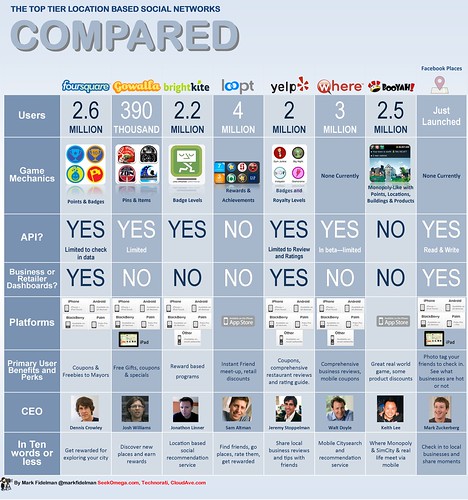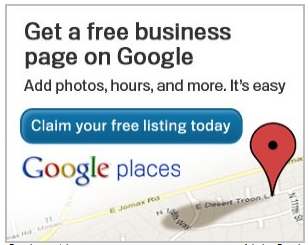 Foursquare, Gowalla, MyTown, Loopt, Yelp… these location based, social media services have varying degrees of participation and collaboration – both with with your immediate social network and those on the perimeter that are able to see your opinion on services, restaurants, stores, etc. Location has been in the news a lot over the last week or so. First, Forrester came out with a report that urged most marketers to ‘forgo’ Foursquare as the adoption rate and penetration was not prevalent enough to make a major impact for a brand marketer outside (their report states that only 4% of U.S. online adults have used location based mobile applications) of a small subset of early adopters.
Foursquare, Gowalla, MyTown, Loopt, Yelp… these location based, social media services have varying degrees of participation and collaboration – both with with your immediate social network and those on the perimeter that are able to see your opinion on services, restaurants, stores, etc. Location has been in the news a lot over the last week or so. First, Forrester came out with a report that urged most marketers to ‘forgo’ Foursquare as the adoption rate and penetration was not prevalent enough to make a major impact for a brand marketer outside (their report states that only 4% of U.S. online adults have used location based mobile applications) of a small subset of early adopters.
Soon after, an opposing opinion made the case for the use of such location based services – not specifically for reach and depth of penetration, but for the impact made by the influencers that are participating on a regular basis. These influencers have the ability to amplify their small sample size greatly by distributing through their larger than average social presence. For example – a Foursquare user that connects his or her ‘check-in’ with their Twitter Feed or Facebook account has the ability to distribute a potential brand message much wider than if they did not tie into those services. From my vantage point, I think you’ll see brands leverage services like Foursquare in a way that mimics what Old Spice did with YouTube and Twitter – targeting those celebrity and power users with a large social presence and tailoring specific message to them in an effort to extend the Old Spice brand through affiliation with their famous personas. Very clever, very viral, and exceedingly simple to do – the first time.
But will we get tired of sharing our information and whereabouts with our social graph? Is there also a limit to ‘what’ people are actually willing to check-in to? Many of us understand the benefit of checking into a restaurant, an airport, or an activity like a concert – as humans, we are social by nature and have a penchant for sharing the fun things we are doing with our friends. We are seeing more and more, however, that brands are building activities and campaigns that have people checking in to ‘static’ mediums like print advertisements, movie posters, billboards, etc. Where is the limit of our threshold for this type of activity? How much is too much? Is there such a thing as check in ‘fatigue’? Yes – and I’ll quote a nice summary pulled from a recent Ad Age article:
“If we don’t tie check-ins to real-world rewards, then we will miss out on a great opportunity to affect consumer behavior by avoiding “check-in fatigue” that will inevitably be brought about by a lack of value attributed to the action. Stickers and badges (even while scarce) will eventually become devalued as they become less scarce and hold less perceived value, and will not be a strong enough incentive to keep people engaged.”
The moral is that don’t build a campaign where you are forcing people to take an action that will not result in a real world, tangible value. It’s one thing to be exposed to an advertisement – it’s an action consumers are exposed to thousands of times a day. The majority of those exposures are passive. If we’re asking our loyal brand advocates to take an action, as marketers, we’d better provide them with an incentive to do so. A perceived reward for their loyalty and their advocacy of our brand to their personal network. Regardless of their location.
David Veneski Location Based Marketing, Uncategorized Foursquare, Geolocation, Gowalla

 Anyone see the irony in this image? If I were Google, I’d be a ‘little’ bit upset with the name of the service (for the uninformed, see:
Anyone see the irony in this image? If I were Google, I’d be a ‘little’ bit upset with the name of the service (for the uninformed, see: 



